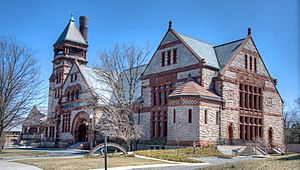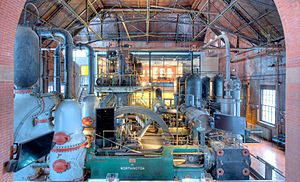Metropolitan Waterworks Museum facts for kids
 |
|
| Owner | Metropolitan Waterworks Museum Inc. |
|---|---|
| Public transit access |
Green Line (D branch)
Reservoir |
| Location | 2450 Beacon Street, Chestnut Hill, Massachusetts, US |
| Architect | Arthur H. Vinal |
| Architectural style(s) | Richardsonian Romanesque |
|
U.S. Historic district
Contributing property |
|
| Official name: Chestnut Hill High Service Pumping Station | |
| Designated | January 18, 1990 |
| Part of | Chestnut Hill Reservoir Historic District |
| Reference no. | 89002271 |
The Waterworks Museum is a cool place to visit in Boston. It's located inside a historic building called the Chestnut Hill Waterworks. This building used to be a huge pumping station that helped provide water to the city.
The museum is special because it has amazing old machines that are still in great condition. The building itself is also very interesting, built in a style called Richardsonian Romanesque. When it was busiest, this waterworks pumped over 100 million gallons of water every day!
The pumping station stopped working in the 1970s. Later, some parts of the building were turned into homes. After being unused for a while, the main pumping station was fixed up. In 2007, a group called the Waterworks Preservation Trust started working to turn it into a museum. The building officially opened its doors as the Waterworks Museum in March 2011.
Contents
History of Boston's Water Supply
In the 1850s, the city of Boston started to improve how it got its water. Before this, people used water from wells, ponds, and pipes that brought water downhill from a reservoir in Natick.
By the 1870s, Boston's leaders realized the city needed even more water. They decided to make the water cleaner and pump it to more places. So, they began looking for new ways to do this.
Building the Chestnut Hill Pumping Station
In 1886, the plans for this "high service" pumping station were created. It started working the very next year as the Chestnut Hill pumping station. This was only a few years after the first station of its kind was built in Germany. Water was pumped from this station up to the Fisher Hill reservoir. From there, gravity would help push the water to homes and businesses in the surrounding area.
The Famous Leavitt-Riedler Pumping Engine
In 1894, the station added its third water pump. This was a powerful steam-powered pump designed by Erasmus Darwin Leavitt. It was later called the Leavitt-Riedler Pumping Engine. When it was first shown to the public, people said it was "the most efficient pumping engine in the world." This amazing machine kept working until 1928.
Later, the American Society of Mechanical Engineers recognized it as a historic mechanical engineering landmark. The museum has fully restored this engine, and it is now the main attraction on the museum's ground floor.
Fun Facts About the Museum Building
- The famous actor Mark Wahlberg filmed part of his 1992 music video "You Gotta Believe" in the basement of this building.
- Look closely at the stonework on the building! You can find faces carved into the stone. These are the faces of the building's designer, Arthur H. Vinal, and his wife.
See also
 In Spanish: Museo Metropolitano de Waterworks para niños
In Spanish: Museo Metropolitano de Waterworks para niños
- Chestnut Hill Reservoir Historic District
- Leavitt-Riedler Pumping Engine
- Waltham Water Works Shop


